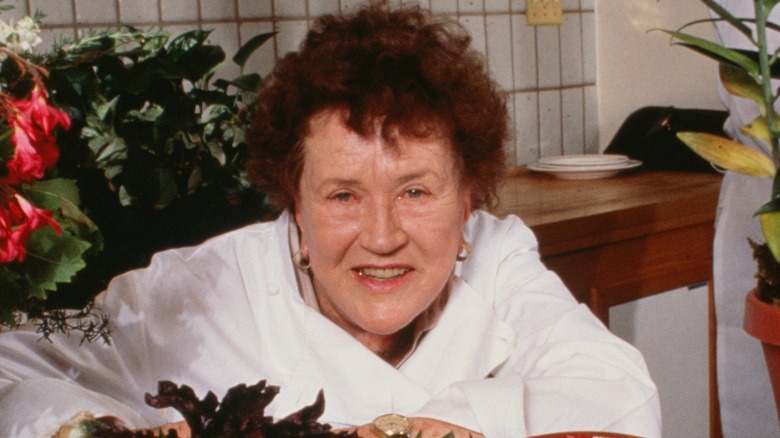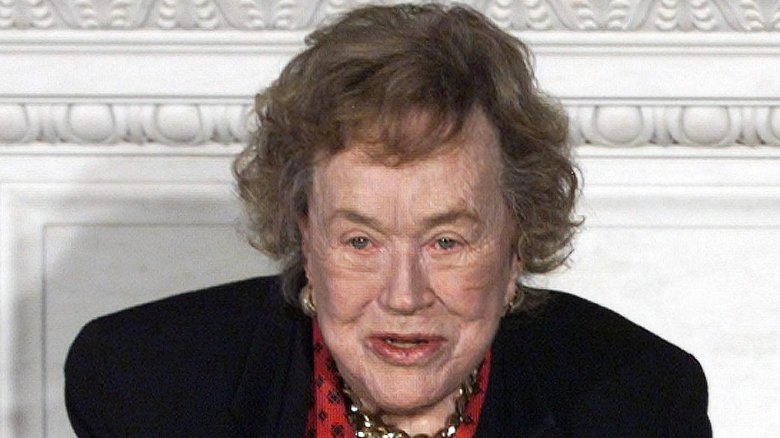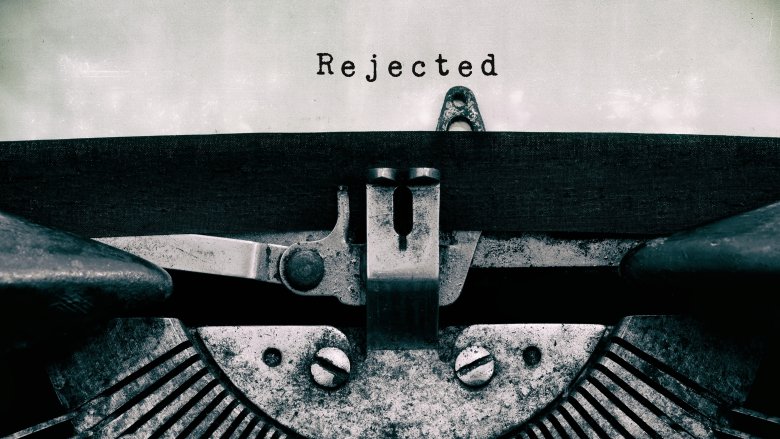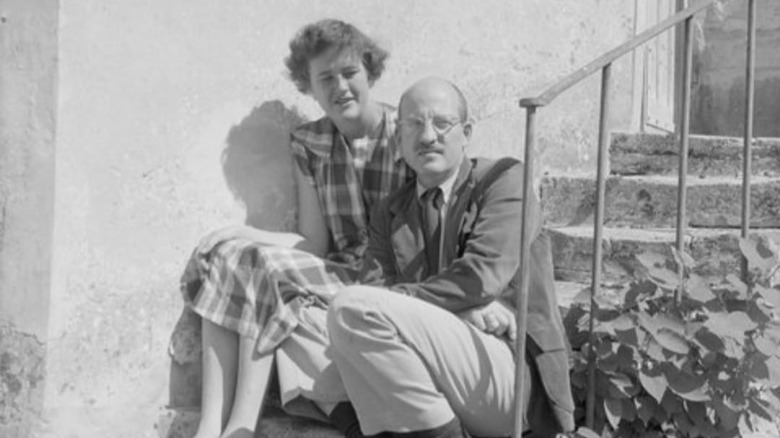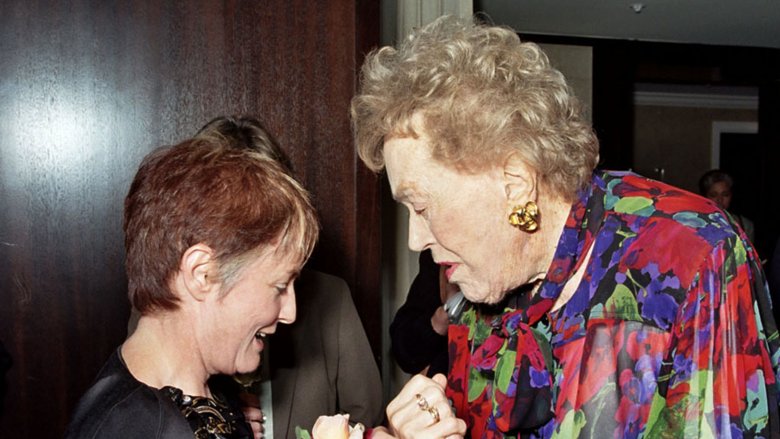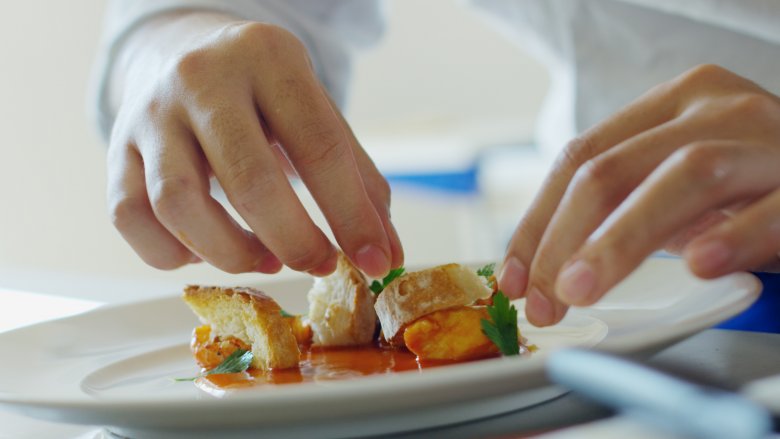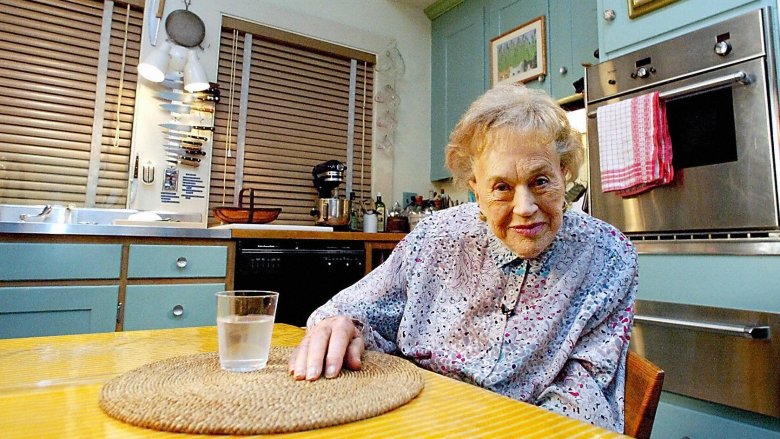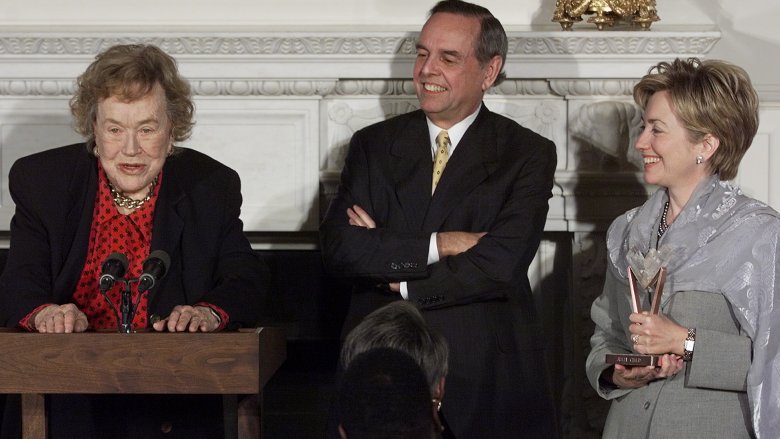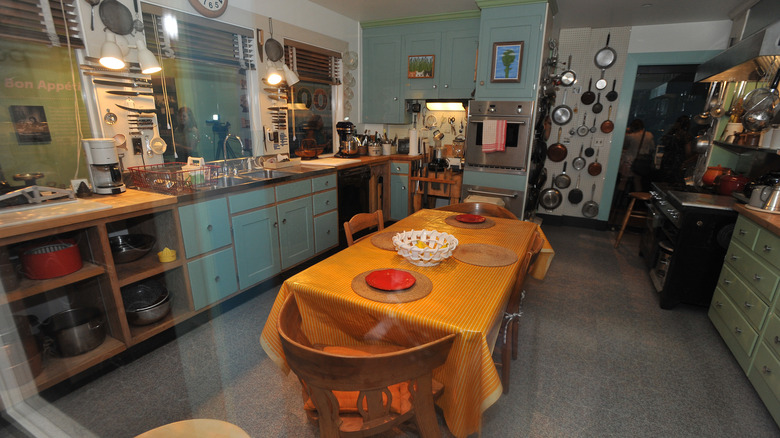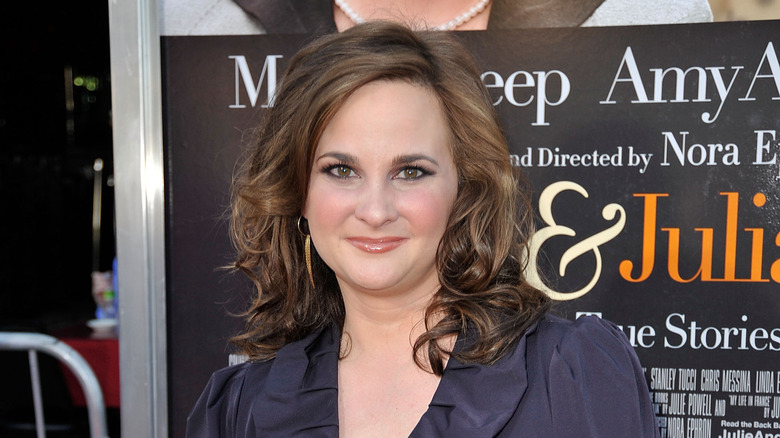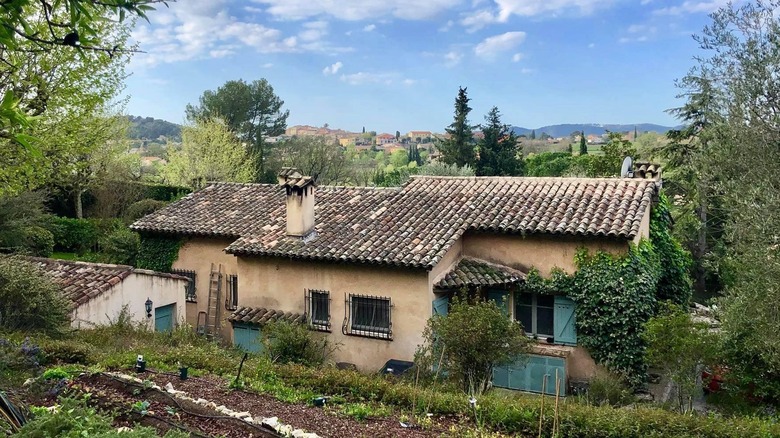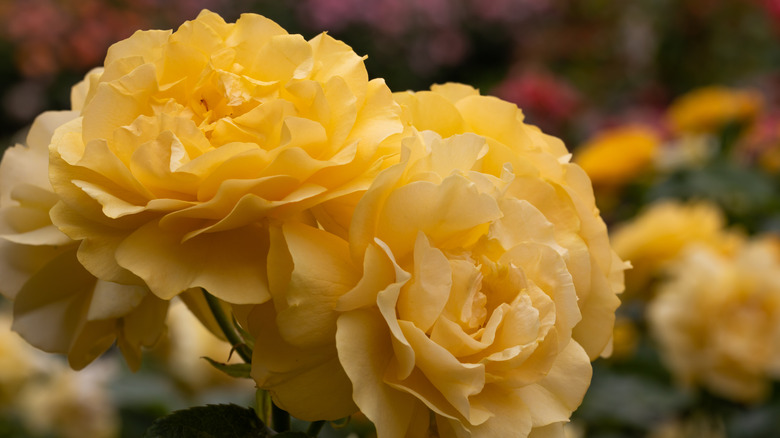The Untold Truth Of Julia Child
Julia Child famously said, "Find something you're passionate about and keep tremendously interested in it." Child had many passions in her life: writing, her relationship with her husband, Paul, and serving her country, just to name a few. She lived a long life — she died at age 91 — and she seemed to love every minute of it. Though food wasn't her first love and she wasn't French, she ended up teaching millions of Americans how to cook real French food via her television shows and books. Her warm, funny, slightly cranky persona endeared her to her legions of fans.
But who was the real woman behind the simmering pots of delicious French food? What secrets did she have up her (rather long) sleeves? You might be surprised at how varied and colorful her life really was. From spy to writer to cooking show host to living legend, this is the untold truth of Julia Child.
She originally wanted to be a writer
Long before Julia Child started cooking, she dreamt of being a writer. She graduated from Smith College in 1934, after which she began pursuing her dream to be a novelist. A 1974 profile of Child in The New Yorker recounted her story. She told the interviewer, "They laughed when I sat down at the typewriter. And they were right, too, because nothing much ever came of the plan. I wrote for the Smith College Tatler, and after I graduated I went home for a while, and then I went to New York and tried to get a job with The New Yorker, but they turned me down."
Instead, she settled for a copywriting job with the W. & J. Sloane furniture store in New York. Decades later, she published her famous cookbook, "Mastering the Art of French Cooking," and then went on to pen over 15 other cookbooks as well as an autobiography, "My Life in France."
It turned out that Child was destined to be a bestselling author — just not in the way she originally intended.
She was a late bloomer
Child didn't meet her husband Paul until she was 31 years old, and she married at age 34, which was considered unusual in the 1940s. Even though she made a huge impact on the world with her cooking, she didn't actually discover her passion for it until she turned 36.
In her autobiography, "My Life in France" (via NPR), Child remembered, "As a girl I had zero interest in the stove. I've always had a healthy appetite ... but I was never encouraged to cook and just didn't see the point in it." She only became interested in cooking when she married Paul, who had been raised by a mother who knew how to cook.
She signed up for a "bride-to-be" cooking class before their wedding. The first meal she made for Paul, brains simmered in red wine, came out terribly, according to Julia (via The New York Times). "The results, alas, were messy to look at and not very good to eat. In fact, the dinner was a disaster!" she wrote. But this only made her more determined to learn how to cook well. She didn't let her age, or her lack of experience, stop her from learning something new.
She failed many times before she succeeded
Child's determined attitude, and her many failures, extended far beyond her first foray into the kitchen. She faced failure many times over before she created the success she's known for today.
In 1950, she failed her first cooking exam from Le Cordon Bleu, an experience that infuriated her. She described the experience in "My Life in France" (via Alex Prud'homme, the book's co-writer): "I was stuck, and had no choice but to make everything up. I knew I would fail the practical part of the exam ... My disgruntlement was supreme, my amour-propre enraged, my bile overboiling. Worst of all, it was my own fault." She went home and cooked three of the recipes she had failed to learn before the exam and then ate all of them.
Child's famous cookbook, "Mastering the Art of French Cooking," also faced rejection before it was published. Houghton Mifflin rejected the manuscript in 1959, claiming that it was too long. Paul Brooks, the editor, wrote, "It is a big, expensive cookbook of elaborate information and might well prove formidable to the American housewife. She might easily clip one of these recipes out of a magazine but be frightened of the book as a whole." Luckily for Child, and for American kitchens, that wasn't the end of the cookbook. Alfred A. Knopf finally published the book in 1961 and it sold more copies than anyone had anticipated. According to The New Yorker, critic Michael Field said it "surpasses every other American book on French cooking in print today."
Her husband Paul was way more involved in her career than people realized
Paul Child, Julia's loving husband, wasn't just her initial motivation to learn how to cook — he was also instrumental in furthering her career. In "The French Chef Cookbook" (via the Los Angeles Times), Julia wrote, "Paul Child, the man who is always there: porter, dishwasher, official photographer, mushroom dicer and onion chopper, editor, fish illustrator, manager, taster, idea man, resident poet, and husband."
Paul retired from the State Department when he was 60 years old, and from then on, dedicated his life to helping Julia further her career. He critiqued her writing, built her iconic kitchen, cooked with her, and went on the road with her to promote her books. As recounted in "The French Chef in America" by Alex Prud'homme (via Town and Country Magazine) Julia said, "Without Paul Child, I would not have had my career."
Many have written about the Childs' marriage as an example of a truly supportive union. In Smithsonian Magazine, Ruth Reichl wrote, "Few men of Paul Child's generation would have been able to enjoy their wife's success as he did ... When I look at this kitchen I see the legacy of a remarkable couple who were not only creating a food revolution, but also redefining what a modern marriage might be."
She was an intelligence officer
Child joined the Office of Strategic Services (OSS), the predecessor of the CIA, in 1942. In 1944, the OSS sent her to Ceylon (what we now know as Sri Lanka) and China to serve as Chief of the OSS Registry. Her duties included handling "highly classified papers that dealt with the invasion of the Malay Peninsula," according to History.
Fisher Howe, Child's friend and a fellow OSS Officer, shared in an interview quoted by CBS, "We became fast friends there. Julia was head of the secretariat, the documents control, and she was a genial person, and we rode elephants and went to restaurants together."
Child received the Emblem of Meritorious Civilian Service for her work with the OSS. Her OSS personnel file stated, "Her drive and inherent cheerfulness, despite long hours of tedious work, served as a spur to greater effort for those working with her. Her achievements reflect great credit upon herself and the Armed Forces of the United States."
She invented a shark repellent (but it didn't actually work)
Before Julia Child made her first souffle, she cooked up something else — shark repellent. Prior to her time as the Chief of the OSS Registry and just a few months after she joined the newly formed OSS, Child and her fellow OSS officers began the search for an effective shark repellent. According the CIA Archive, "At least twenty US Naval officers had been attacked by sharks since the start of the war, raising alarm amongst sailors and airmen who increasingly found themselves conducting dangerous missions over shark-infested waters."
The OSS tried over 100 different substances before they settled on copper acetate as the main ingredient for their repellent. It proved only mildly effective, but was widely used by the Armed Forces anyway. "Even if the repellent wasn't guaranteed to drive sharks away, it would at least provide possible deterrence against bites and have a huge effect on seamen and pilot morale," the CIA Archive explained.
Child told Betty Mcintosh, another officer, for her book "Sisterhood of Spies," "I understand the shark repellent we developed is being used today for downed space equipment — strapped around it so the sharks won't attack when it lands in the ocean" (via The Washington Post). While rumors of this did arise in the 1970s, they have not been verified by the CIA.
She was really, really tall
If you've seen videos of Julia Child cooking, you already know that her personality was larger than life. But did you know that she was extremely tall, as well? At 6'2", Child towered over most women. She played basketball at Smith College, where her height gave her a natural edge over the other players (via Taste of Home).
In 1943, her height kept her out of the Women Accepted for Volunteer Emergency Service (WAVES) and Women's Army Corps (WAC), which is why she eventually joined the OSS. As she wrote in "My Life in France," "I wanted to do something to aid my country in a time of crisis. I was too tall for the WACS and WAVES, but eventually joined the OSS, and set out into the world looking for adventure."
Child's height also played a part in the making of her famous kitchen. According to Smithsonian Magazine, Paul raised the counters at their house so that she wouldn't have to stoop to stir her marvelous concoctions.
She never considered herself a chef
Considering Child's enormous success as a cook, cooking show star, and cookbook writer, it may shock you to learn that she never considered herself a chef. She called herself a cook, a teacher, and a writer, but never "chef." In an article in Star Chefs, Emily Bell wrote, "Despite being surrounded by chefs, working constantly with chefs, and having many close friendships with chefs, Child never assumed the mantle of the chef herself."
Why then, you may wonder, was Child's famous cooking show called "The French Chef?" In the introduction to the 40th Anniversary Edition of "Mastering the Art of French Cooking," Child wrote "Why The French Chef, since I am neither the one nor the other? The first reason was that I always hoped we would have some real French chefs on the shows. We never managed that until later on."
She had an endearing sense of humor
Child's sense of humor was nearly as delicious as the French cuisine she whipped up. She never took life too seriously and poked fun at everything from her foibles in the kitchen to Americans' fear of butter. Her allowance for mistakes and unapologetic love for food made Americans fall in love with her.
For example, on one of her cooking shows, when pieces of a potato pancake slipped out of the pan as she cooked it, she happily put them back in the pan, saying, "You can always pick it up, and if you're alone in the kitchen, who is going to see?"
Here are a few more of her funniest quotes via Today: "If you're afraid of butter, use cream," "I enjoy cooking with wine. Sometimes, I even put it in the food," and "A party without cake is really just a meeting."
Child kept her sense of humor throughout her life. On an appearance on David Letterman in 1987, she started out her hamburger-making demonstration by saying, "This is some of the best meat that came over from Good Morning America." Then, when Letterman's burner failed to work, she transformed what could have been a disaster into a hilarious improvisation. She piled the raw meat up, added cheese, and then lit it on fire with a blowtorch. When Letterman nearly refused to eat it, she proclaimed, "I like you anyway," and then embraced him and smiled at the camera.
She won over 45 awards and distinctions in her lifetime
Child won many awards in her 91 years, the first of which was the Emblem of Meritorious Civilian Service awarded by the OSS. This was followed by the George Foster Peabody Award, which she won in 1964 for "The French Chef." Two years later, she won her first Emmy Award.
In 1993, Child was the first woman to be inducted into the The Culinary Institute of America's Hall of Fame. Her awards also include honorary doctorates from Harvard University, Brown University, Rutgers University, and Newberry College. She won six Book Awards and was nominated for eight Emmys total, three of which she won.
President George W. Bush presented Child with the Presidential Medal of Freedom in 2003. Upon presenting her award, he said, "Before Julia Child came along, no one imagined it could be so interesting to watch a meal being prepared. The reason, of course, is Julia, herself — her friendly way, her engaging conversation, and her eagerness to teach. American cuisine and American culture have been enriched for decades by the unmistakable voice and the presence of Julia Child."
She was fired from one of her first jobs
When someone achieves legendary status, it seems to erase all of their past mistakes. With someone as iconic as Julia Child, we tend to believe that she was destined for greatness from birth, and was on the fast track to stardom no later than kindergarten. Well, it's reassuring to know that even the great ones stumble from time to time, and one of Child's early missteps may have been a doozy.
Getting fired from a job is always a black mark in anyone's book, and translating it into modern corporate jargonese by saying "terminated for cause" doesn't soften the blow one bit. And yet terminated Child was, from her job as a copywriter for furniture emporium W. & J. Sloane. While we don't know all the details, Biography drops a juicy detail: The cause behind her firing was apparently gross insubordination. Did she swipe too many pencils, or did she moon the general manager? We may never know exactly what happened, but it makes us love her all the more knowing that she not only messed up a time or two, but when she did, she did it in a big way.
She refused to endorse any products
Few things can be more disheartening than turning on the TV and seeing a once-admired celebrity shilling for some cheesy product in what appears to be a blatant cash grab. You kind of alternate between feeling sorry for them and just feeling disappointed. No, Emeril, we're not buying your crappy AirFryer 360! Despite, or perhaps because of, her early attempt at an advertising career, Julia Child consistently refused to endorse any products. As her great-nephew, Alex Prudhomme, told the Los Angeles Times, "Your name is your most valuable asset, and you should be very careful how it's used."
Once Child was no longer with us, however, certain companies tried to sneak in a posthumous endorsement, much to the chagrin of Child's heirs. In 2012, as the Los Angeles Times reports, the Julia Child Foundation for Gastronomy and the Culinary Arts got into some legal wrangling with Thermador over its ad campaign capitalizing on Child's use of its ovens. A few years later, the Foundation was once again in court (and in the Los Angeles Times) over an Airbnb promotion that invoked the late great French chef. Oddly enough, while Child's foundation is firmly opposed to her resurrection via TV commercial, it has apparently given its approval to her afterlife incarnation as the host of a reality cooking competition called "The Julia Child Challenge." What would Julia think? Guess we'll never know without a ouija board.
Her kitchen is a literal museum piece
When you watch Julia Child on TV, even knowing that you're seeing decades-old reruns, you feel almost as if you've been welcomed inside her home. In fact, in some of these shows we do see her hard at work in her very own kitchen. The TV crews had to take out the back cabinets and replace the table and chairs with a more TV-friendly cooking island to facilitate the filming, but most of the furnishings we see, as well as all of the utensils and the kitchenware, did belong to Child.
In 2001, Child generously gifted the entire kitchen from her Cambridge, Massachusetts home to the Smithsonian Institution where it now holds pride of place in the National Museum of American History Food exhibit. This means that everyone can now get a look behind the scenes where food history was made and peek into the kitchen where six-plus decades of magical moments took place.
She was bemused by becoming a blogger's obsession
Julia Child, who died in 2004, was not around to see her life turned into a movie. There have been a few of these by now, but the first one was 2009's "Julie and Julia," a movie that depicted the primarily one-sided relationship between Child and the blogger who became obsessed with recreating each dish in her magnum opus. Child, however, was very much alive and kicking when Julie Powell began her odyssey of cooking her way through "Mastering the Art of French Cooking" and documenting her efforts online.
While Child didn't exactly object to Powell's efforts, she didn't really see the point of them either, which is something Powell herself admits. She says that while the two of them never met face-to-face, Child was aware of her blog and didn't seem to care for it. As Powell sees it, Child wasn't mad about the blog, but she didn't really know why it needed to exist. At first, Powell found this upsetting, but she seems to bear no posthumous grudge against her chosen mentor. As for Child, she's reported to have commented on Powell's efforts, "I don't think she's a serious cook" and objected not only to the blog's copious use of 4-letter words but also to the "stunt" of cooking a recipe a day for the sake of the blog.
Her cottage in Provence is now an Airbnb
Child may have been known to millions as "The French Chef," but for 40 years she made her home in Cambridge, Massachusetts. She did, however, have a little pied-a-terre in Provence — and who wouldn't, if circumstances permitted? While her Cambridge home is now off-limits to tourists (all but the kitchen that was relocated to the Smithsonian), you can not only visit her cottage on the Cote d'Azur but even spend the night ... if you've got about $900 to spare, that is.
La Pitchoune, a 3-bedroom cottage, was built by Child and her husband on the grounds of the home owned by Simone Beck. Beck, it seems, was the co-author of "Mastering the Art of French Cooking," but she failed to get a TV deal out of the gig. (Chrissy Teigen collaborator Adeena Sussman may feel her pain.) Child's former cottage is, appropriately enough, the site of a cooking school today, but during the off-season, it's rented out for overnight stays by Airbnb. While the price is pretty steep, the kitchen is as amazing as you would expect, and you even get fresh-laid eggs from onsite hens. What's more, the cottage is said to sleep six adults, with the possibility of cramming in a couple of additional kids. If you're feeling flush, you can rent a week at La Pitchoune for $18,000, which comes with four gourmet meals and all the wine you can drink.
But her childhood home is a crumbling wreck
As a child, Julia Child lived in a home that was, if not an actual mansion, pretty darn close. Her family home was an early 20th-century craftsman that's been described as architecturally significant but is now sadly neglected. As the Pasadena Star-News reports, the property has been unoccupied for over 35 years and is currently owned by the California Department of Transportation. Caltrans originally purchased it, probably with the intent of demolition, to prepare for a freeway expansion that seems to have been canceled. While the house has been boarded up to keep squatters from moving in, there's been little else done to the property. It's not listed for sale, and apparently, efforts to have it included on the National Register of Historic Places have yet to bear fruit.
Other former homes of Child's have met a kinder fate. One of her other childhood homes, also in Pasadena, is home to a family whose remodeling efforts are detailed in Pasadena Magazine. In the District of Columbia, a Georgetown townhouse once owned by Child sold for over $3 million.
A rose the color of butter bears her name
Some celebrities have the dubious honor of lending their names to beetles, slugs, and parasitic wasps, while others inspire frogs, fish, or ferns. British naturalist Sir David Attenborough has no fewer than 18 species bearing his name, ranging from a dinosaur to a mini marsupial. Julia Child has only a single namesake, but it's one of the loveliest on this list: a lush yellow rose that she selected shortly before her death.
The Julia Child rose was developed in 2004 by Weeks Roses, and, according to Weeks, Child chose it for its "butter gold" hue as well as its "licorice candy" scent — always with the food references! Not only does the sunny color perfectly suit Child's personality, but so does the fact that her rose is known for its abundant blooms, its overall hardiness, and its ability to grow well in nearly every kind of climate. What's more, its flowers are popular with birds, bees, butterflies, and anyone who appreciates a beautiful bloom. In 2006, the Julia Child rose even earned one of the rose world's top honors: It was selected as an All-American Rose Selections winner.
